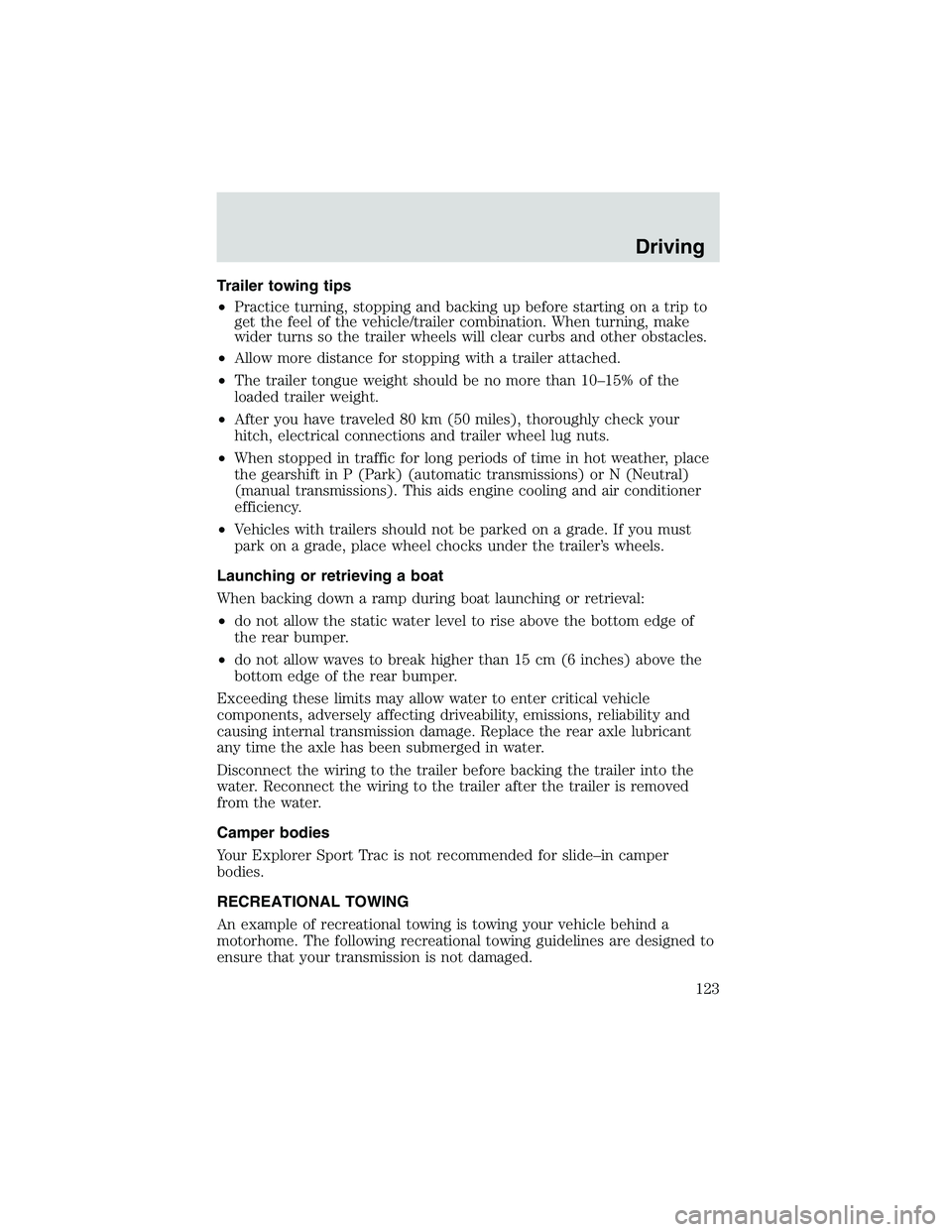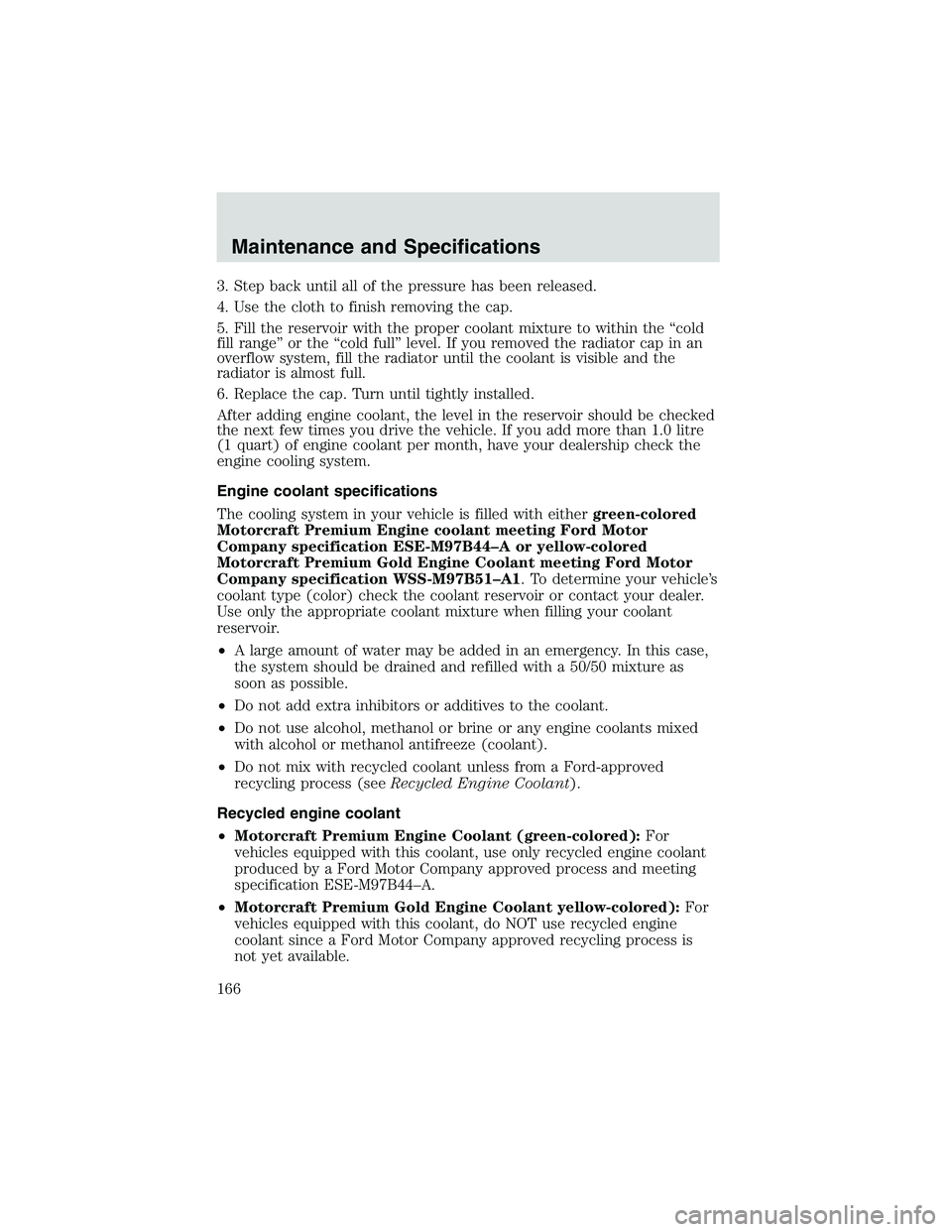Page 123 of 200

Trailer towing tips
•Practice turning, stopping and backing up before starting on a trip to
get the feel of the vehicle/trailer combination. When turning, make
wider turns so the trailer wheels will clear curbs and other obstacles.
•Allow more distance for stopping with a trailer attached.
•The trailer tongue weight should be no more than 10–15% of the
loaded trailer weight.
•After you have traveled 80 km (50 miles), thoroughly check your
hitch, electrical connections and trailer wheel lug nuts.
•When stopped in traffic for long periods of time in hot weather, place
the gearshift in P (Park) (automatic transmissions) or N (Neutral)
(manual transmissions). This aids engine cooling and air conditioner
efficiency.
•Vehicles with trailers should not be parked on a grade. If you must
park on a grade, place wheel chocks under the trailer’s wheels.
Launching or retrieving a boat
When backing down a ramp during boat launching or retrieval:
•do not allow the static water level to rise above the bottom edge of
the rear bumper.
•do not allow waves to break higher than 15 cm (6 inches) above the
bottom edge of the rear bumper.
Exceeding these limits may allow water to enter critical vehicle
components, adversely affecting driveability, emissions, reliability and
causing internal transmission damage. Replace the rear axle lubricant
any time the axle has been submerged in water.
Disconnect the wiring to the trailer before backing the trailer into the
water. Reconnect the wiring to the trailer after the trailer is removed
from the water.
Camper bodies
Your Explorer Sport Trac is not recommended for slide–in camper
bodies.
RECREATIONAL TOWING
An example of recreational towing is towing your vehicle behind a
motorhome. The following recreational towing guidelines are designed to
ensure that your transmission is not damaged.
Driving
123
Page 165 of 200

ENGINE COOLANT
Checking engine coolant
•Check the level of engine coolant
when the engine is cold.
•The coolant should be at the
“cold fill level”or with the“cold
fill range”as listed on the engine
coolant reservoir.
•Refer to theScheduled
Maintenance Guidefor service
interval schedules.
Make sure to use a 50/50 mixture of engine coolant and distilled water.
Do not add engine coolant when the engine is hot. Steam and
scalding liquids released from a hot cooling system can burn you.
You can also be burned if you spill coolant on hot engine parts.
Do not put engine coolant in the windshield washer fluid
container. If sprayed on the windshield, engine coolant could
make it difficult to see through the windshield.
Note:Automotive fluids are not interchangeable; do not use engine
coolant, antifreeze or windshield washer fluid outside of its specified
function.
For vehicles with overflow coolant systems with a non-pressurized cap
on the coolant recovery system, add coolant to the recovery reservoir
when the engine is cool. Add the proper 50/50 coolant mixture to the
“cold full”level. For all other vehicles, follow these steps to add engine
coolant.
1. Turn the engine off and let it cool.
2. When the engine is cool, wrap a thick cloth around the coolant
pressure relief cap on the reservoir. Slowly turn the cap
counterclockwise until pressure begins to release.
RADIATOR
COOLANT
ONLY
WASHERFLUIDONLY
Maintenance and Specifications
165
Page 166 of 200

3. Step back until all of the pressure has been released.
4. Use the cloth to finish removing the cap.
5. Fill the reservoir with the proper coolant mixture to within the“cold
fill range”or the“cold full”level. If you removed the radiator cap in an
overflow system, fill the radiator until the coolant is visible and the
radiator is almost full.
6. Replace the cap. Turn until tightly installed.
After adding engine coolant, the level in the reservoir should be checked
the next few times you drive the vehicle. If you add more than 1.0 litre
(1 quart) of engine coolant per month, have your dealership check the
engine cooling system.
Engine coolant specifications
The cooling system in your vehicle is filled with eithergreen-colored
Motorcraft Premium Engine coolant meeting Ford Motor
Company specification ESE-M97B44–A or yellow-colored
Motorcraft Premium Gold Engine Coolant meeting Ford Motor
Company specification WSS-M97B51–A1. To determine your vehicle’s
coolant type (color) check the coolant reservoir or contact your dealer.
Use only the appropriate coolant mixture when filling your coolant
reservoir.
•A large amount of water may be added in an emergency. In this case,
the system should be drained and refilled with a 50/50 mixture as
soon as possible.
•Do not add extra inhibitors or additives to the coolant.
•Do not use alcohol, methanol or brine or any engine coolants mixed
with alcohol or methanol antifreeze (coolant).
•Do not mix with recycled coolant unless from a Ford-approved
recycling process (seeRecycled Engine Coolant).
Recycled engine coolant
•Motorcraft Premium Engine Coolant (green-colored):For
vehicles equipped with this coolant, use only recycled engine coolant
produced by a Ford Motor Company approved process and meeting
specification ESE-M97B44–A.
•Motorcraft Premium Gold Engine Coolant yellow-colored):For
vehicles equipped with this coolant, do NOT use recycled engine
coolant since a Ford Motor Company approved recycling process is
not yet available.
Maintenance and Specifications
166